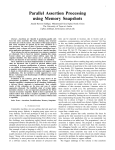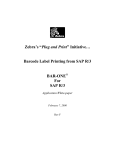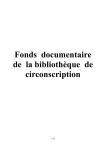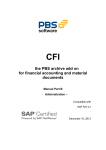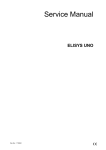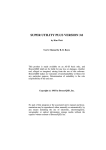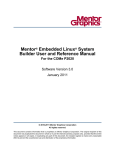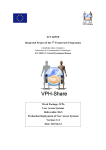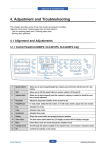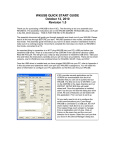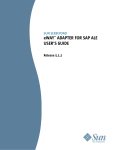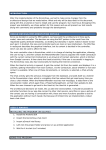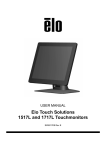Download EMC ViewPoint for SAP Contract Account Documents Module
Transcript
EMC ViewPoint for SAP Contract Account Documents Module Version 2.0 ADMINISTRATION MANUAL P/N 300-003-424 REV A01 EMC Corporation Corporate Headquarters: Hopkinton, MA 01748-9103 1-508-435-1000 www.EMC.com Copyright © 2006 EMC Corporation. All rights reserved. Published February, 2006 EMC believes the information in this publication is accurate as of its publication date. The information is subject to change without notice. THE INFORMATION IN THIS PUBLICATION IS PROVIDED “AS IS.” EMC CORPORATION MAKES NO REPRESENTATIONS OR WARRANTIES OF ANY KIND WITH RESPECT TO THE INFORMATION IN THIS PUBLICATION, AND SPECIFICALLY DISCLAIMS IMPLIED WARRANTIES OF MERCHANTABILITY OR FITNESS FOR A PARTICULAR PURPOSE. Use, copying, and distribution of any EMC software described in this publication requires an applicable software license. For the most up-to-date listing of EMC product names, see EMC Corporation Trademarks on EMC.com. All other trademarks used herein are the property of their respective owners. ii EMC ViewPoint for SAP CFICA Module Administration Manual Contents Preface ............................................................................................................................. v Chapter 1 Introducing ViewPoint for SAP CFICA Module Introduction ...................................................................................... 1-2 ViewPoint CFICA Module.............................................................. 1-3 Navigation ................................................................................. 1-3 Chapter 2 CFICA Module Archiving Archiving in the SAP R/3 system ................................................. 2-2 General customizing of the transaction SARA ............................ 2-3 Technical settings ...................................................................... 2-5 Basic customizing ..................................................................... 2-7 User specific customizing ............................................................... 2-8 Document runtimes.................................................................. 2-9 SAP archiving infrastructure ................................................ 2-11 Archiving job .................................................................................. 2-13 Creating variants..................................................................... 2-13 Maintaining variants .............................................................. 2-13 Start date and spool parameters........................................... 2-15 Archiving cycle ....................................................................... 2-16 Chapter 3 CFICA Module Index Generation and Administration Administration Board ..................................................................... 3-2 Description of the individual icons........................................ 3-2 Changing the view ................................................................... 3-4 Index generation .............................................................................. 3-5 Indexing program ..................................................................... 3-5 EMC ViewPoint for SAP CFICA Module Administration Manual iii Contents Consolidation ............................................................................ 3-9 Examples of index generation .............................................. 3-10 Analysis of existing index areas .................................................. 3-15 Scanning index areas.............................................................. 3-15 Validation of index construction .......................................... 3-17 Test accesses ............................................................................ 3-17 Chapter 4 CFICA Module Transactions Administrative transactions........................................................... 4-2 Display transactions ........................................................................ 4-3 iv EMC ViewPoint for SAP CFICA Module Administration Manual Preface As part of an effort to improve and enhance the performance and capabilities of its product line, EMC from time to time releases revisions of its hardware and software. Therefore, some functions described in this manual may not be supported by all revisions of the software or hardware currently in use. For the most up-to-date information on product features, refer to your product release notes. If a product does not function properly or does not function as described in this manual, please contact your EMC representative. ViewPoint Functionality Audience This document describes how to administer the various components that make up EMC ViewPoint for SAP Contract Account Documents (CFICA) Module. EMC’s technology allows you to effectively manage your application data by providing the ability to define the access, retention, and service level requirements for any business transaction at each point in its lifecycle. This guide is part of the ViewPoint documentation set, and is intended for use by anyone administering the ViewPoint for SAP CFICA Module. It is assumed that the installer has a working knowledge of SAP Basis, and has the appropriate levels of responsibilities to perform the tasks described. EMC ViewPoint for SAP CFICA Module Administration Manual v Preface Related Documentation Be sure to review the EMC ViewPoint for SAP Release Notes for the most up-to-date information on product features. The following list of related documents are available on the EMC ViewPoint for SAP Documentation CD that was delivered with your EMC ViewPoint SAP software CD. Both the release notes and documentation CD can be found at: http://Powerlink.EMC.com Introductory V EMC ViewPoint for SAP Documentation CD V EMC ViewPoint for SAP Release Notes Installation V EMC ViewPoint for SAP Modules Installation Manual V EMC ViewPoint for SAP Analyzer Plus Installation and User Manual V EMC ViewPoint for SAP BW Analyzer Installation Manual V EMC ViewPoint for SAP Construction and Maintenance Installation Manual V EMC ViewPoint for SAP Fiscal Year Reporter Module Installation and User Manual Miscellaneous V EMC ViewPoint for SAP Material Master Data, Batches, Special Stocks, and BOMs Module Modification Manual Administrative V EMC ViewPoint for SAP Controlling Line Items Module Administration Manual V EMC ViewPoint for SAP Financial Accounting and Material Documents Module Administration Manual V EMC ViewPoint for SAP Purchasing Module Administration Manual V EMC ViewPoint for SAP Sales and Distribution Module Administration Manual V EMC ViewPoint for SAP Production Orders Module Administration Manual V EMC ViewPoint for SAP Agency Business Module Administration Manual V EMC ViewPoint for SAP Construction and Maintenance Module Administration Manual vi EMC ViewPoint for SAP CFICA Module Administration Manual Preface V EMC ViewPoint for SAP Costing-Based Profitability Analysis Module Administration Manual V EMC ViewPoint for SAP Master Data Changes Module Administration Manual V EMC ViewPoint for SAP Data Retention Tool Module Administration Manual V EMC ViewPoint for SAP Contract Account Documents Module Administration Manual V EMC ViewPoint for SAP HR Archiving Objects Module Administration Manual V EMC ViewPoint for SAP Material Ledger Documents Module Administration Manual V EMC ViewPoint for SAP Material Master Data, Batches, Special Stocks, and BOMs Module Administration Manual V EMC ViewPoint for SAP Controlling Orders Module Administration Manual V EMC ViewPoint for SAP Profit Center Line Items Module Administration Manual V EMC ViewPoint for SAP Plant Maintenance Module Administration Manual V EMC ViewPoint for SAP Production Orders Module Administration Manual V EMC ViewPoint for SAP Process Orders Module Administration Manual V EMC ViewPoint for SAP Project Systems Module Administration Manual V EMC ViewPoint for SAP Line Items Module Administration Manual V EMC ViewPoint for SAP Special Ledger Module Administration Manual V EMC ViewPoint for SAP Warehouse Management Module Administration Manual V EMC ViewPoint for SAP Custom Module Administration Manual User V EMC ViewPoint for SAP Analyzer Plus Installation and User Manual V EMC ViewPoint for SAP Analyzer Lite Installation and User Manual EMC ViewPoint for SAP CFICA Module Administration Manual vii Preface V EMC ViewPoint for SAP Analyzer BW User Manual V EMC ViewPoint for SAP Controlling Line Items Module User Manual V EMC ViewPoint for SAP Financial Accounting and Material Documents Module User Manual V EMC ViewPoint for SAP Purchasing Module User Manual V EMC ViewPoint for SAP Sales and Distribution Module User Manual V EMC ViewPoint for SAP Production Orders Module User Manual V EMC ViewPoint for SAP Modules Utilities User Manual V EMC ViewPoint for SAP Agency Business Module User Manual V EMC ViewPoint for SAP Construction and Maintenance Module User Manual V EMC ViewPoint for SAP Costing-Based Profitability Analysis Module User Manual V EMC ViewPoint for SAP Master Data Changes Module User Manual V EMC ViewPoint for SAP Contract Account Documents Module User Manual V EMC ViewPoint for SAP HR Archiving Objects Module User Manual V EMC ViewPoint for SAP Material Ledger Documents Module User Manual V EMC ViewPoint for SAP Material Master Data, Batches, Special Stocks, and BOMs Module User Manual V EMC ViewPoint for SAP Controlling Orders Module User Manual V EMC ViewPoint for SAP Profit Center Line Items Module User Manual V EMC ViewPoint for SAP Plant Maintenance Module User Manual V EMC ViewPoint for SAP Production Orders Module User Manual V EMC ViewPoint for SAP Process Orders Module User Manual V EMC ViewPoint for SAP Project Systems Module User Manual V EMC ViewPoint for SAP Special Ledger Module User Manual V EMC ViewPoint for SAP Export Interface for Special Ledger Data User Manual V EMC ViewPoint for SAP Warehouse Management Module User Manual viii EMC ViewPoint for SAP CFICA Module Administration Manual Preface V EMC ViewPoint for SAP Fiscal Year Reporter Module Installation and User Manual Conventions Used in This Guide EMC uses the following conventions for notes, cautions, warnings, and danger notices. Note: A note presents information that is important, but not hazard-related. ! CAUTION A caution contains information essential to avoid data loss or damage to the system or equipment. The caution may apply to hardware or software. WARNING A warning contains information essential to avoid a hazard that can cause severe personal injury, death, or substantial property damage if you ignore the warning. DANGER A danger notice contains information essential to avoid a hazard that will cause severe personal injury, death, or substantial property damage if you ignore the message. Typographical Conventions EMC uses the following type style conventions in this guide: bold • User actions (what the user clicks, presses, or selects) • Interface elements (button names, dialog box names) • Names of keys, commands, programs, scripts, applications, utilities, processes, notifications, system calls, services, applications, and utilities in text italic • Book titles • New terms in text • Emphasis in text Courier • • • • • • Prompts System output Filenames Pathnames URLs Syntax when shown in command line or other examples EMC ViewPoint for SAP CFICA Module Administration Manual ix Preface Where to Get Help Courier, bold • User entry • Options in command-line syntax Courier italic • Arguments in examples of command-line syntax • Variables in examples of screen or file output • Variables in pathnames <> Angle brackets for parameter values (variables) supplied by user. [] Square brackets for optional values. | Vertical bar symbol for alternate selections. The bar means or. ... Ellipsis for nonessential information omitted from the example. EMC support, product, and licensing information can be obtained as follows. Product information — For documentation, release notes, software updates, or for information about EMC products, licensing, and service, go to the EMC Powerlink website (registration required) at: http://Powerlink.EMC.com Technical support — For technical support, go to EMC WebSupport on Powerlink. To open a case on EMC WebSupport, you must be a WebSupport customer. Information about your site configuration and the circumstances under which the problem occurred is required. Your Comments Your suggestions will help us continue to improve the accuracy, organization, and overall quality of the user publications. Please send your opinion of this guide to: [email protected] x EMC ViewPoint for SAP CFICA Module Administration Manual 1 Invisible Body Tag Introducing ViewPoint for SAP CFICA Module This chapter includes these topics: V Introduction ........................................................................................1-2 V ViewPoint CFICA Module................................................................1-3 Introducing ViewPoint for SAP CFICA Module 1-1 Introducing ViewPoint for SAP CFICA Module Introduction The ViewPoint modules are constructed in modular form and cover the application modules FI, SD, MM, CO, etc. with a special program package for exactly this application. You can easily see from the name which ViewPoint module belongs to which SAP module: FI, SD, MM, CO, etc. All ViewPoint modules have in common that they can be easily installed in the SAP R/3 system via the SAP transport utilities "tp" and "SAINT". Installation details of the ViewPoint modules are in the EMC ViewPoint for SAP Modules Installation Manual. This administration manual was written to make construction and administration of the ViewPoint CFICA Module as easy as possible. At first, data archiving with transaction SARA is discussed; the second topic is the ViewPoint index construction from the SAP archive files. The EMC ViewPoint for SAP Modules Utilities User Manual contains additional module information. 1-2 EMC ViewPoint for SAP CFICA Module Administration Manual Introducing ViewPoint for SAP CFICA Module ViewPoint CFICA Module Although the term reorganization was often used in R/2 to mean the archiving of completed documents, the first term is today mainly used to describe the physical reorganization of the database, whereas the second means the transfer of completed documents to sequential files. In this handbook, the term archiving is used completely in the SAP sense. We use the term archiving to mean collectively the processes that are controlled by SAP programs for checking whether documents can be archived, the writing of these documents to sequential archive files, and the removal of the documents from the database. Archiving is controlled centrally by the SAP transaction SARA, as described in “CFICA Module Archiving” on page 2-1. ViewPoint now provides a package of programs with the ViewPoint CFICA Module that makes SAP archive files so accessible to the user as if they had never been archived. In order to also completely relieve the load on the database due to index data, the documents are read from the SAP archive files by the ViewPoint index generation programs and, equipped with all necessary index information, are written to the archiving object /PBS/CFICA using the function module of SAP archiving. We call this process indexing, or setup of the ViewPoint CFICA Module. Navigation The area menus /PBS/PBS (main menu of the ViewPoint modules) and /PBS/CFICA (functions of contract accounts receivable and payable) are included in the ViewPoint CFICA Module. Roles are to be generated from these menus, which can then be incorporated in the user master. An activity group or role can be created directly from the Easy Access Menu, as shown in Figure 1-1, “Easy Access menu.” Figure 1-1 Easy Access menu ViewPoint CFICA Module 1-3 Introducing ViewPoint for SAP CFICA Module The name of the activity group or role can be chosen freely and can also lie in the ViewPoint namespace. A ViewPoint area menu is then copied by pressing the function key ’Copying of menus from area menus’ and specifying the respective ViewPoint menu name. When copying, the system query that is displayed after expanding the area menu should be answered ’Yes’. The activity group or role created in this way can then be incorporated in the respective user master. It is recommended that administrators are assigned the global activity group/role /PBS/PBS, and end users the special function menu /PBS/CFICA, as shown in Figure 1-2, “Global activity group/role /PBS/PBS.” Figure 1-2 1-4 Global activity group/role /PBS/PBS EMC ViewPoint for SAP CFICA Module Administration Manual Introducing ViewPoint for SAP CFICA Module More information about the creation of activity groups or roles can be found in the current SAP standard documentation, as shown in Figure 1-3, “Initial menu of the ViewPoint CFICA Module.” Figure 1-3 Initial menu of the ViewPoint CFICA Module ViewPoint CFICA Module 1-5 Introducing ViewPoint for SAP CFICA Module 1-6 EMC ViewPoint for SAP CFICA Module Administration Manual 2 Invisible Body Tag CFICA Module Archiving This chapter includes these topics: V V V V Archiving in the SAP R/3 system ...................................................2-2 General customizing of the transaction SARA ..............................2-3 User specific customizing .................................................................2-8 Archiving job ....................................................................................2-13 CFICA Module Archiving 2-1 CFICA Module Archiving Archiving in the SAP R/3 system Even if you are already familiar with the transaction SARA and the customizing of the archiving object FI_MKKDOC, you should still read this chapter carefully, since a number of settings have to be made at this early stage that have an influence on the subsequent setup of the ViewPoint Module. This chapter is by no means intended to replace the extensive SAP documentation on this complex topic which can be found in SAPNet under the title "Managing SAP R/3 Archiving Projects". It is strongly recommended that you also read this documentation. 2-2 EMC ViewPoint for SAP CFICA Module Administration Manual CFICA Module Archiving General customizing of the transaction SARA The menus of the transaction SARA vary slightly from one another in the different SAP releases. Here we deal with the customizing in release 4.64, but the settings that are described are also valid for other releases and can be made there in the corresponding places. These are generally easy to find, even if in detail they are sometimes different to what is in release 4.64. After calling the transaction SARA, the following initial screen is displayed, as shown in Figure 2-1, “Initial screen of the transaction SARA.” Figure 2-1 Initial screen of the transaction SARA You should now enter the archiving object covered by the ViewPoint Module (FI_MKKDOC) under Object name and then choose the pushbutton Customizing. General customizing of the transaction SARA 2-3 CFICA Module Archiving The following popup is displayed as in Figure 2-2, “Selection of customizing transactions for archiving object FI_MKKDOC.” Figure 2-2 2-4 Selection of customizing transactions for archiving object FI_MKKDOC EMC ViewPoint for SAP CFICA Module Administration Manual CFICA Module Archiving Technical settings Figure 2-3 If you now choose the first of the selection options (Technical settings), the view seen in Figure 2-3, “General technical settings,” appears. General technical settings Here, the button Verification time Read must be deactivated. If this is not the case, the archive is read sequentially each time a document is accessed individually. General customizing of the transaction SARA 2-5 CFICA Module Archiving If you now choose the second of the selection options (Technical settings), the view shown in Figure 2-4, “Technical settings (default values that can be used),” displays. Figure 2-4 Technical settings (default values that can be used) The defaulted logical file name ARCHIVE_DATA_FILE can usually be kept. Although 25 MB or 30,000 data objects is defaulted for the Size of an archive file, SAP recommends of late to choose 100 MB here (and a maximum of 120,000 data objects = documents). We also recommend that this setting is made. If more documents than are specified here 2-6 EMC ViewPoint for SAP CFICA Module Administration Manual CFICA Module Archiving are archived during an archiving run, a follow-on file is opened under the same sequential number. The Connection to the archiving system plays a role in the case of optical archiving and is not covered within the scope of this handbook. Basic customizing The next option in the popup, as seen in Figure 2-4, “Technical settings (default values that can be used),” is Basic Customizing. This deals with the assignment of logical to physical file names and paths. Generally it is not necessary to make any changes here. General customizing of the transaction SARA 2-7 CFICA Module Archiving User specific customizing In order to perform an archiving run for the contract account documents, a number of prerequisites must be fulfilled. Decisions regarding whether a document can be archived must be made. The most important and accounting criteria such as whether the document is cleared are already checked by the archiving program. Furthermore, on the one hand the document runtimes must be maintained and on the other hand the archiving infostructure must be activated. This can be done for the archiving object FI_MKKDOC under: ’ Transaction "SPRO" ’ Select "SAP Reference IMG" ’ See menu structure in Figure 2-5, “Customizing for archiving object FI_MKKDOC.” Figure 2-5 2-8 Customizing for archiving object FI_MKKDOC EMC ViewPoint for SAP CFICA Module Administration Manual CFICA Module Archiving Document runtimes A completely cleared document also remains in the database as long as the archiving program does not try to archive it. The runtimes that can be maintained here must have elapsed after the clearing date for the document to be able to be transferred to the archive file. These runtimes therefore represent the minimum runtimes that the document can remain in the database after its clearing date. In this way, it is possible to define that documents that can be archived are not immediately archived. However, from a technical perspective, this is not sensible (due to the load on the database) and is not necessary from an accounting perspective when using the ViewPoint CFICA Module. User specific customizing 2-9 CFICA Module Archiving For this reason, we strongly recommend that all runtimes are set to the lowest possible value, which is one day, as shown in Figure 2-6, “Document type runtimes, recommended default setting (archiving object FI_MKKDOC).” Figure 2-6 Document type runtimes, recommended default setting (archiving object FI_MKKDOC) It makes more sense to define elsewhere which of the documents that can be archived should actually be archived and which should remain in the database using the posting period and fiscal year, as described in “Archiving job” on page 2-13. The runtimes are generally specified in days. If a runtime (or even an account type or document type) has not been maintained, the runtime is defaulted as 9999 days. In order to really archive, meaning to remove documents from the database, it must be ensured that all runtimes and account types have been maintained. 2-10 EMC ViewPoint for SAP CFICA Module Administration Manual CFICA Module Archiving In the last column of this maintenance screen, the runtime of the archive index can be specified. This is irrelevant within the scope of the archiving object FI_MKKDOC, because when the ViewPoint Module is being used, the SAP archive indices are not required, as described next in “SAP archiving infrastructure”. SAP archiving infrastructure The Archive Information System (AS) is a generic tool fully integrated in the SAP data archiving environment for performing searches in data archives. The search and display of data is based on so-called archive information structures that can be defined and by the user and filled with data from the archive. In the case of the archiving object FI_MKKDOC, this is the structure "SAP_FICA_DOC001". To be able to archive the contract account documents in the SAP R/3 System, this archive information structure must however be active. This is predetermined by the SAP archiving programs. To activate the archive information structure, the customizing described in “General customizing of the transaction SARA” on page 2-3, must be called and then the icon "Activate" selected, as shown in Figure 2-7, “Activation of the SAP archive infostructure.” Figure 2-7 Activation of the SAP archive infostructure The filling of the archive information structures takes place during the deletion phase within an archiving process. When the ViewPoint CFICA Module is being used, this information is however not required and it takes up unnecessary disk space in the database. It is this additional load on the database as a result of the standard setup of indices for the SAP archive information structure during archiving that users of ViewPoint software actually want to avoid. For this reason, the indices of the archive information structure User specific customizing 2-11 CFICA Module Archiving should be removed after data archiving has taken place. To do this, proceed as follows: V Call transaction "SARI". V Click on the Start button in the menu bar. V Enter "FI_MKKDOC" as the archiving object, as shown in Figure 2-8, “Enter archiving object.” Figure 2-8 Enter archiving object V Choose "Status per archive". Select the ADKs for which the structure is constructed, as shown in Figure 2-9, “Remove SAP archive information structure.” Choose "Delete structures", also shown in Figure 2-10, “Create variants for archiving job.” Figure 2-9 2-12 Remove SAP archive information structure EMC ViewPoint for SAP CFICA Module Administration Manual CFICA Module Archiving Archiving job Creating variants Figure 2-10 Maintaining variants In the initial screen of the transaction SARA, a shown in Figure 2-1, “Initial screen of the transaction SARA,” the object name FI_MKKDOC must be entered and the pushbutton Archive selected. The screen shown in Figure 2-10, “Create variants for archiving job,” appears, in which a variant name should be entered. One after another, the start date and the spool parameters must now be maintained (pushbutton Maintain) for the variants. Create variants for archiving job Here, the scope of the data to be archived is defined. For this, three factors should play a role: V Accounting requirements (which data should remain in the database) V Database load (archive archiving objects with a high data volume first) V Keeping administration easy (clear range of documents that are to be archived) Since the archived documents are just as quick and easy to access as database documents when using the ViewPoint CFICA Module, the first point does not play a significant role. Where there is a large volume of documents being created, archiving can by all means be carried out on a monthly basis and completed documents of the current fiscal year can be transferred to the archive. It is never necessary to keep completed documents from completed fiscal years in the database. Archiving job 2-13 CFICA Module Archiving For this reason, the second point is of much greater importance. If you do not know exactly which database tables and which archiving objects put the greatest load on your database, we can recommend you our database analysis tool, the ViewPoint Database Analyzer. Generally, you should also aim to keep the R/3 database lean since the performance of display transactions and batch evaluations is then much better. It is particularly important for the archiving runs themselves that the database is not unnecessarily full. The archiving runtime namely increases at least in proportion to the data volume in the database and can rise to unpleasantly high values (several days) if archiving has not taken place for too long a period. If an overdue archiving run then has to be postponed because there is no longer enough time even at the weekend for the archiving run to take place, you can end up entering a vicious circle. This situation should be avoided as soon as possible. Finally, it makes sense to define simple ranges when archiving in order to guarantee completeness and clarity, as shown in Figure 2-11, “Maintenance of the variants for the archiving job.” Figure 2-11 2-14 Maintenance of the variants for the archiving job EMC ViewPoint for SAP CFICA Module Administration Manual CFICA Module Archiving Archiving of the documents is performed in a two-step procedure. First, both the straightforward clearing documents and statistical documents are archived. This involves "simple" documents such as payments and no open items. In a second step, the rest, meaning all other more complicated documents, are archived. These can only be archived once the corresponding clearing documents have been archived in the first step. For this reason the archiving strategy should be adhered to, otherwise the optimal data quantity cannot be archived. The key date for archiving is the reference date for the validation of the document type runtimes, as described in “Document runtimes” on page 2-9. If no other date is entered here, the field is filled automatically with the current date. Furthermore, it is possible to specify the Minimum number of days in the system. Here, it is possible to specify how many days a document must have at least been in a system since its creation, in order to be able to be archived. In the field Remark, a comment should be entered for identification purposes. In the block Program parameters it is important that Test run has not been selected. If you were to check this parameter, the archiving would only be simulated but an archive file would not be created and documents would not be removed from the database. Equally, in the case of mass data, the parameter to only show errors in the detail log should be checked. Start date and spool parameters The start date should now be defined and the spool parameters maintained. The settings made here depend on the specific situation and conventions that exist at the customer's company. We would simply recommend that the archiving run is scheduled at a time when the load on the system is low (for example, during the night or at the weekend). When archiving is to take place for the first time after a long period of uncontrolled database growth, a maximum of one fiscal year, as shown in Figure 2-11, “Maintenance of the variants for the archiving job,”, or, better still, just one quarter in the case of large data volumes should be archived per archiving run, and at least a complete weekend should be planned for this job (or jobs). Archiving job 2-15 CFICA Module Archiving Archiving cycle 2-16 Subsequent archiving runs should then take place at regular intervals. For example, the volume of your FI-CA documents comprises 100,000 documents per month, meaning that the load on the database increases monthly as a result of the corresponding data volume. An archiving run should be scheduled monthly or quarterly at the latest, followed immediately by an indexing run, meaning a construction run, of the ViewPoint CFICA Module. EMC ViewPoint for SAP CFICA Module Administration Manual 3 Invisible Body Tag CFICA Module Index Generation and Administration This chapter includes these topics: V Administration Board........................................................................3-2 V Index generation ................................................................................3-5 V Analysis of existing index areas.....................................................3-15 CFICA Module Index Generation and Administration 3-1 CFICA Module Index Generation and Administration Administration Board As already mentioned, the R/3 archiving object FI_MKKDOC is covered by the ViewPoint CFICA Module. The function modules of SAP archiving are used for storing the indices in the system. The archiving object /PBS/CFICA was created for this purpose. The ViewPoint Administration Board is the central administration instrument for the indices that are generated via the ADK technique and that were stored in so-called archiving runs (index areas). The initial screen of the Administration Board that can be called with the transaction /PBS/CFICA_Y00 (program /PBS/CFICA_FILE) is displayed in Figure 3-1, “CFICA Administration Board.” Figure 3-1 CFICA Administration Board Description of the individual icons 3-2 EMC ViewPoint for SAP CFICA Module Administration Manual CFICA Module Index Generation and Administration Table 3-1 Icon Icon descriptions Description You can use this function to move an index area from the main index into the long term index or vice-versa. The index area is available within the main index for further merging and consolidation. The index area is not automatically made available as a long term index for further processing for index generation. Furthermore, the access here can be limited. This corresponds to the previous ViewPoint long term archive. Converting a main index into a merge index ensures that this index area is no longer subject to the automatic merge of the index generation. It is possible to restrict access rights for the long term index. Here you can define and maintain the user groups. By activating an index area, the indices are made available for the user. Only deactivated index areas can be activated. Deactivation of an index area means that these indices are no longer available to the user. The deletion of an index area results in all dependent table contents and physical files being deleted. You can use the validation to perform a check for completeness and correctness of the index generation. By checking an index area it is possible to establish whether it can be read completely and whether it was generated coherently. In the index area information you can see which SAP archive files were indexed and some statistical values such as the lowest and highest value of each index per company code. The log of the run provides information about the number of processed indices, the runtime and the selection criteria. The program /PBS/CFICA_SCAN can be used to display the content of a selected index area. You can select this button to call the program /PBS/CFI_U001. Here, it is possible to test the access to the archive index. This program can be used as a template for your customer specific modifications. With index generation it is possible to index ADK files from the archiving object FI_MKKDOC. The indices are also stored in ADK files. The archiving object used for this is /PBS/CFICA. The consolidation function can be used to combine several index areas together. This is advantageous as far as the runtime is concerned when accessing the indices. It is preferable to consolidate the existing main index areas and then to move them into the long term index after the completion of a year. Administration Board 3-3 CFICA Module Index Generation and Administration Changing the view The Main, Long term, and Inactive buttons can be used to switch between the main and long term indices as well as the display of inactive index areas. The status of the individual index areas is indicated within the respective display via traffic light icons: V green = main archive (further indices can be merged with those here) V yellow = long term archive V red = inactive indices. As soon as a new index area is created by the merging of further indices or by consolidation, the previous areas are moved to the inactive indices unless the option "Delete former index at runtime" was selected. The manual moving of index areas is performed using the respective icons described above. Long term archive The index areas in the long term archive are no longer taken into consideration by the indexing program during automatic processing for the merge procedure. It is assumed that these remain unchanged and form a logical unit such as the archiving of a single fiscal year. Additional access restrictions can be defined for these index areas. By activating the option "Batch", access is restricted to programs running in the background. By making an entry in the field "User group", access can be restricted to a particular user group. These groups can be edited by selecting the User group for long term index icon. 3-4 EMC ViewPoint for SAP CFICA Module Administration Manual CFICA Module Index Generation and Administration Index generation Indexing program Figure 3-2 Select manually Index generation was enhanced for the ViewPoint CFICA Module compared to the previous functionality of the other ViewPoint modules. The most important function enhancement is parallel indexing and also the possibility to consolidate several index areas. This makes it possible to process several archive files simultaneously and to minimize the number of index areas. The individual parameters are shown in Figure 3-2, “CFICA index generation selection screen,” and are explained in more detail in the following. CFICA index generation selection screen With the manual selection option you can select the FI_MKKDOC archive files yourself via a popup window. The selection list can be restricted using a date interval (date of archive file creation) and by non-indexed archive files. The parameter "Max. number of phys. files" can be used to restrict the number of archive files per index generation. You only need to perform this restriction if your sort capacities in the SAP system are Index generation 3-5 CFICA Module Index Generation and Administration not sufficient. For example, if seven archive files are selected and you have specified that a maximum of two files can be processed, four index generations are performed, as shown in Figure 3-3, “Select manually.” Figure 3-3 Select automatically Figure 3-4 Delete old runs Figure 3-5 Input control for document input 3-6 Select manually If the option "Select automatically" is chosen, all archive files that were created within the specified date interval are processed. The parameter "Max. number of phys. files" has the same functionality as shown in Figure 3-4, “Select automatically.” Select automatically This function can be used to delete indices within an index area. After selecting the button 'Run', a list of the indexed FI_MKKDOC archive files is displayed. The list contains the indexed archive files of the last main index that was created. All generated indices for an archive file can be deleted, as shown in Figure 3-5, “Delete old runs.” Delete old runs You can use this function to perform a further restriction of the required sort area by specifying the number of documents when manually selecting an archive file. EMC ViewPoint for SAP CFICA Module Administration Manual CFICA Module Index Generation and Administration You can name the first and last document of an archive file for a run. As standard, all documents are to be processed. as shown in Figure 3-6, “Input control document.” Figure 3-6 Input control document If an archive file is to be constructed using sequential number intervals, you should ensure that the intervals are specified without overlaps (1 to 200000, 200001 to 400000, 400001 to 600000, etc.). Otherwise, you run the risk of individual documents being indexed twice in the ViewPoint index area. There is no automatic check for this. Input control for index generation Figure 3-7 Output control for index generation When merging index areas it is possible to choose between the last main index and a manually selected index area. As standard, the current main index should be used. In special cases such as a deletion run in a long term index, an alternative index can be selected, as shown in Figure 3-7, “Input control for index generation.” Input control for index generation All parameters that concern the newly created index area are grouped together in this block. By checking the option 'Activate index at runtime', the generated index area is immediately made available to users for accessing. If the index is not activated, it is stored as an inactive index area and can then be activated via the Administration Board. Index generation 3-7 CFICA Module Index Generation and Administration If more index generations take place than the number of archive files, this is only possible via index activation, as shown in Figure 3-8, “Output control for index generation.” Figure 3-8 Output control for index generation After an index area has been merged, the index area that was read is no longer required and can be deleted immediately after index generation has been completed. To do this, the parameter 'Delete previous index at runtime' should be checked. By deactivating this parameter, the index area is set to inactive and can be deleted manually in the Administration Board. The advantage of this is that you can keep the index area for longer and can use it to restore an intermediate status in the event of errors occurring. When processing the individual index generations, you can choose between two variants. The first variant is sequential processing and the second parallel processing. In the case of sequential processing, the input is merged with the newest main index. This process can be repeated ad infinitum but has the disadvantage that the runtimes can increase steeply because the input that is to be added has to be merged with all of the other files. In order to restrict this, the number of merge runs can be limited to a certain number. Once this value (Runs per main index) has been reached, a further main index is created and processed further until the maximum number of runs has been reached again. The result of this in the long term is that the runtimes for index generation remain constant, but the number of main index areas increases. However, a larger number of index areas that is available to the users increases runtimes during evaluations, particularly when accessing individual documents. This can be counteracted by consolidating a given number of main index areas. In this case, a consolidation program is 3-8 EMC ViewPoint for SAP CFICA Module Administration Manual CFICA Module Index Generation and Administration started that combines the existing main index areas into one main index area. In the case of parallel processing, it is possible to do without merge runs completely and to divide up the individual index generations between several processes and servers. Here, it is also possible to perform a consolidation afterwards in order to improve runtimes when accessing documents. This variant only makes sense if you have to perform a large number of index generations. Consolidation Figure 3-9 The Consolidation pushbutton in the Administration Board can be used to combine manually several index areas into one index, providing consolidation functionality that is in addition to the automatic option that was described above. This consolidation results in greater clarity and reduces access times when accessing the archive, as shown in Figure 3-9, “Consolidation area in the Administration Board.” Consolidation area in the Administration Board It is possible to select the index areas manually or to use all main index areas. The program has to process a minimum of two and a maximum of 90 index areas, as shown in Figure 3-10, “Input control index consolidation.” Figure 3-10 Input control index consolidation The generated index area can be made available to users via the option 'Activate index at runtime'. The input areas can be deleted after the index area has been generated. Index generation 3-9 CFICA Module Index Generation and Administration The result can be checked using a test run without changes being made, as shown in Figure 3-11, “Output control index consolidation.” Figure 3-11 Examples of index generation Completely new construction or reconstruction 3-10 Output control index consolidation The following examples illustrate how to perform index generation as quickly and as easily as possible. When performing the data selection, you should restrict this to one archive year (all archive files that were created in one year); you should set the number of maximum physical files high enough so that the number of documents of documents contained in it can be processed in one run (Extract/Sort Restriction). In the Output control for index generation you should select "Parallel processing with subsequent consolidation. You can use the pushbutton "Scheduling server" to select the server and the number of processes. After index generation has been completed, you should move the created index area into the long term index. EMC ViewPoint for SAP CFICA Module Administration Manual CFICA Module Index Generation and Administration Repeat this procedure until all archive years (apart from the current archive year) have been processed, as shown in Figure 3-12, “New index construction.” Figure 3-12 Periodic archiving with subsequent index generation New index construction 1 to 3 archive files are created per archiving run. When performing the archive file data selection, you should choose the automatic option and set the 'To' date far into the future that you can also use the same variant in the future. In the Output control for index generation you should select "Sequential processing" with the option of runs per main index set to 10 for 10 complete main index areas. Index generation 3-11 CFICA Module Index Generation and Administration After completion of an archive year, consolidation should be performed if you have several main index areas and you should move the index into the long term index, as shown in Figure 3-13, “Subsequent index construction.” Figure 3-13 Normal archiving with subsequent index generation 3-12 Subsequent index construction More than three archive files were created. When performing the archive file data selection, you should choose the automatic option and set the 'To' date far into the future that you can also use the same variant in the future. In the Output control for index generation you should select "Parallel processing with subsequent consolidation. EMC ViewPoint for SAP CFICA Module Administration Manual CFICA Module Index Generation and Administration After completion of a fiscal year, should move the main index area into the long term index, as shown in Figure 3-14, “Normal subsequent index construction.” Figure 3-14 Moving a main index area into a long term index. Normal subsequent index construction After completion of an archive year, you should move the main index area into the long term index. This is done by marking the index area and selecting the corresponding icon. The "long term indices" are concerned with the longer term data retention of the ViewPoint indices. These files are no longer changed, meaning no more new indices are merged with them. Index generation 3-13 CFICA Module Index Generation and Administration Here, access can also be restricted at user or batch job level per index area, as shown in Figure 3-15, “Moving index construction.” Figure 3-15 Creation; enhancement; changing of a long term index 3-14 Moving index construction When doing this, all main indices must first be moved temporarily into the long term index. Afterwards, the long term index that is to be modified must be moved into the main index. This step can be omitted if you want to generate a new long term index. An archive year can then be generated as described in Example 1. After index generation has been completed, you should move the generated index area into the long term index and the temporarily stored long term indices back into the main index area. EMC ViewPoint for SAP CFICA Module Administration Manual CFICA Module Index Generation and Administration Analysis of existing index areas Scanning index areas A number of problems for performing validation and test accesses are available for analyzing the ViewPoint Archive indices. The program "/PBS/CFICA_SCAN" can be used to search the archive selectively according to specific criteria. This corresponds to the well known archiving tool from other ViewPoint Modules such as CFI. This tool can be started from the Administration Board via the scanning. Analysis of existing index areas 3-15 CFICA Module Index Generation and Administration In the initial screen you can choose between the various ViewPoint indices for a test access or protocol display, as shown in Figure 3-16, “Analysis tool /PBS/CFICA_SCAN.” Figure 3-16 Analysis tool /PBS/CFICA_SCAN If, for example, you want to search for a particular document number in the archive, then you must enter this number in the corresponding field (see Diagram 13) before the program is executed. You can then go down to the next view levels via double-click. These four levels are: V Index cluster; (here, for example, by double-clicking on the first line for the cluster of the document number being searched for) V ViewPoint indices; list of the archive indices of an index cluster 3-16 EMC ViewPoint for SAP CFICA Module Administration Manual CFICA Module Index Generation and Administration V Content of the individual document; table entries of the archived document V Individual table entry; fields and content Validation of index construction The validation program, which can be called up via the Validation icon, can be used to obtain an overview of the correct indexing of the FI_MKKDOC files. The result is a list which provides information about which files were correctly indexed and which were not or are erroneous. The check program can be started via the Check index area icon and can be used to check an individual ViewPoint index area for errors. When doing this, the index area is read and checked for errors. Test accesses The program "/PBS/CFICA_U001" ("Test access") is started by selecting the Test access icon. This program can be used to test whether the access to the archive works correctly for the different ViewPoint indices. The respective index and a search criteria (for example, a specific document number) can be entered. This program uses the standard routines, which for the most part are also used in the display transactions and reports, for the access to the ViewPoint indices and/or the archive. This means that this program can be used to test, for example, whether a particular document can be read correctly from the archive. Furthermore, the coding provides a program example for programming manually the archive accesses via ViewPoint indices. Example programs, which each enable the accesses for one ViewPoint index, also exist for the same purpose. These can be found in the EMC ViewPoint for SAP Contract Account Documents Module User Manual. Analysis of existing index areas 3-17 CFICA Module Index Generation and Administration 3-18 EMC ViewPoint for SAP CFICA Module Administration Manual 4 Invisible Body Tag CFICA Module Transactions This chapter includes these topics: V Administrative transactions .............................................................4-2 V Display transactions ..........................................................................4-3 CFICA Module Transactions 4-1 CFICA Module Transactions Administrative transactions The transactions listed in Table 4-1, “Administrative transactions,” are available for calling the programs to construct and manage the ViewPoint indices. Table 4-1 4-2 Administrative transactions Transaction Description /PBS/CFICA_Y00 ViewPoint Archive Administration (Archive Administration Board) /PBS/CFICA_Y02 ViewPoint CFICA Index Generation /PBS/CFICA_Y05 Archiving Tool (ViewPoint Indices Analysis) EMC ViewPoint for SAP CFICA Module Administration Manual CFICA Module Transactions Display transactions The display transactions listed in Table 4-2, “Display transactions,” which read both documents from the operational tables of the SAP system as well as documents from the ViewPoint archive, are available with Final Release 1. The ViewPoint transaction names are created from the corresponding SAP names and prefixed by the ViewPoint namespace "/PBS/". For example, SAP FPE3 becomes /PBS/FPE3. Basically the functionality of the transactions corresponds to the SAP standard transactions, as long as a comparable transaction exists. The detailed description of the transactions can be found in EMC ViewPoint for SAP Contract Account Documents Module User Manual. Table 4-2 Display transactions ViewPoint transaction SAP transaction Description /PBS/FPE3 FPE3 Display document /PBS/FPE4 FPE4 Display document changes /PBS/FPL9 FPL9 Display account balance /PBS/FPT5 FPT5 Display documents for reconciliation key /PBS/FPO1 FPO1 FI-CA key date based open item list /PBS/FPO4 FPO4 Open item evaluation /PBS/FPS_RFKKBELJ00 FPS_RFKKBELJ00 Document journal /PBS/FPDE_EXP FPDE_EXP Document extracts - Export /PBS/FP05 FP05 Process payment lot /PBS/FP09 FP09 Returns /PBS/FPRH FPRH Display installment plan histories /PBS/FPOR3 FPOR3 Display payment order /PBS/FPSEC3 FPSEC3 Display security deposit Display transactions 4-3 CFICA Module Transactions Table 4-2 4-4 Display transactions (continued) ViewPoint transaction SAP transaction Description /PBS/FPM3 FPM3 Display dunning history /PBS/FPM4 FPM4 Display returns history /PBS/ FPCHR FPCHR Check repository EMC ViewPoint for SAP CFICA Module Administration Manual






















































